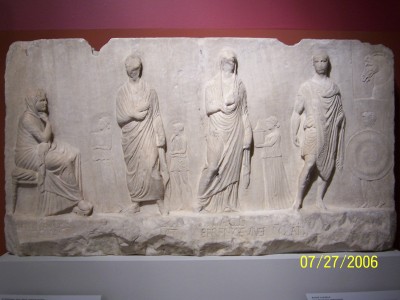|
Slave
Relief
 The
relief sculpture from the Archeological Museum in Thessaloniki
on the left shows a family with their slaves; the slaves are not
as raised and can be seen in the background. This gives a good
idea of the position of slaves in the Greco-Roman world: they
were often intimately tied to the family structure, but clearly
seen as less than full members of the family. The
relief sculpture from the Archeological Museum in Thessaloniki
on the left shows a family with their slaves; the slaves are not
as raised and can be seen in the background. This gives a good
idea of the position of slaves in the Greco-Roman world: they
were often intimately tied to the family structure, but clearly
seen as less than full members of the family.
How is this slave
relief significant for understanding the world of Paul?
In his letter to the Philippians, Paul
writes a "hymn" (a praise poem) about Jesus Christ;
this hymn likely existed before Paul -- he was borrowing from a
song or prayer that already existed in the church.
In this hymn, called the Christ hymn,
Paul calls Jesus a slave.
Let the same mind be in you that was in
Christ Jesus, who, though he was in the form of God, did not
regard equality with God as something to be exploited, but
emptied himself, taking the form of a slave, being born
in human likeness. And being found in human form, he humbled
himself and became obedient to the point of death -- even death
on a cross.
Therefore God also highly exalted him and
gave him the name that is above every name, so that at the name
of Jesus every knee should bend, in heaven and on earth and
under the earth, and every tongue should confess that Jesus
Christ is Lord, to the glory of God the Father. (Chapter
2:5-11)
The Slave in Paul's Day:
Slavery provided the gas of the
Greco-Roman economic engine. People became slaves through
various means: captivity from war, kidnapping by slave hunters
or debt. Slaves exists in all parts of the empire.
Slavery could be quite brutal, especially
for slaves that engaged in mining. However, slaves often were
attached to households and gained a certain amount of
responsibility. Such slaves often helped to raise the children
(even educated them in manners), administer property, earn money
and even sign legal contracts. Some slaves even owned other
slaves. Even after manumission, the freed person would often
pledge themselves to the former master or to a patron.
The slave position within the household afforded some degree of comfort, security and even opportunity
for advancement. However, there was nothing glorious about
slavery. Regardless of their particular status in the house, the
slave did the work that allowed the masters of the house to
participate in civic life.
 How does Paul remix his culture?
How does Paul remix his culture?
Paul talks about slavery very often. In
this letter though, he says that Jesus Christ took on the form
of a slave. Even if slaves were members of the household, one
would not expect the divine to willingly take on the form of a
slave. This is nothing about the formula
Jesus=form of God=form of
slave=exaltation
which would have made sense in the
Greco-Roman cultural milieu. Gods in the ancient world did what they
wanted to with people -- often seize them for their own
purposes, including sex and violence. Instead of seizing his
divine status or seizing people, Christ does the exact opposite
and takes the form of a slave. Paul uses this hymn to remind the
Philippians of the humility Christians are called to.
Paul also makes the point that Jesus does
the hard work of defeating sin, death and the devil for us so
that we might be citizens in the heavenly
kingdom.
sources:
info on slavery: Tambasco, Anthony. In the Day of Paul: The
Social World and Teaching of the Apostle. Paulist Press: New
York, 1991. info on slavery: Meeks, Wayne. The Urban
Environment of Pauline Christianity. New Haven: Yale
University Press, 1983
| 


 The
relief sculpture from the Archeological Museum in Thessaloniki
on the left shows a family with their slaves; the slaves are not
as raised and can be seen in the background. This gives a good
idea of the position of slaves in the Greco-Roman world: they
were often intimately tied to the family structure, but clearly
seen as less than full members of the family.
The
relief sculpture from the Archeological Museum in Thessaloniki
on the left shows a family with their slaves; the slaves are not
as raised and can be seen in the background. This gives a good
idea of the position of slaves in the Greco-Roman world: they
were often intimately tied to the family structure, but clearly
seen as less than full members of the family.